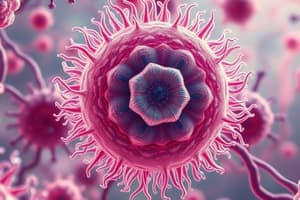Podcast
Questions and Answers
What is the primary function of the rough endoplasmic reticulum?
What is the primary function of the rough endoplasmic reticulum?
- Transporting vesicles to the plasma membrane
- Detoxifying poisons
- Making lipids
- Producing proteins and folding polypeptides (correct)
Which of the following statements about mitochondria is true?
Which of the following statements about mitochondria is true?
- They primarily produce lipids.
- They do not contain their own DNA.
- They are responsible for the synthesis of ATP. (correct)
- Mitochondria only have a single membrane.
What role does the Golgi complex play in the endomembrane system?
What role does the Golgi complex play in the endomembrane system?
- Modifying and packaging proteins (correct)
- Dividing the cytoplasm into compartments
- Breaking down carbohydrates
- Synthesizing lipids
What is one function of the smooth endoplasmic reticulum?
What is one function of the smooth endoplasmic reticulum?
How do mitochondria contribute to cell survival?
How do mitochondria contribute to cell survival?
What is the primary function of the nucleus in a cell?
What is the primary function of the nucleus in a cell?
Which of the following describes a characteristic of prokaryotic cells?
Which of the following describes a characteristic of prokaryotic cells?
What components are common to all cells?
What components are common to all cells?
What is the role of ribosomes in a cell?
What is the role of ribosomes in a cell?
Which statement about eukaryotic cells is true?
Which statement about eukaryotic cells is true?
Flashcards
Prokaryotic Cell
Prokaryotic Cell
A type of cell without a nucleus or membrane-bound organelles, small in size (100nm-5um).
Eukaryotic Cell
Eukaryotic Cell
A type of cell with a nucleus and membrane-bound organelles, larger in size (10-100um).
Ribosomes
Ribosomes
Non-membrane-bound structures responsible for protein synthesis, made of rRNA and proteins.
Nucleus
Nucleus
Signup and view all the flashcards
Plasma Membrane
Plasma Membrane
Signup and view all the flashcards
Endoplasmic Reticulum (ER)
Endoplasmic Reticulum (ER)
Signup and view all the flashcards
Rough ER
Rough ER
Signup and view all the flashcards
Smooth ER
Smooth ER
Signup and view all the flashcards
Mitochondria
Mitochondria
Signup and view all the flashcards
Golgi Complex
Golgi Complex
Signup and view all the flashcards
Study Notes
Course Objectives
- Understand the structure of cells
- Correlate cell structures with basic functions
Cell Theory
- The cell is the smallest unit of life
- All organisms are composed of one or more cells
- New cells arise from previously existing cells
Types of Cells
- Prokaryotic:
- No nucleus
- No organelles
- Small (100nm-5µm)
- Eukaryotic:
- True nucleus
- Membrane-bound organelles
- Larger (10-100µm)
Eukaryotic Cells and Organelles
- Nucleus:
- Double membrane (lipid bilayer)
- Pores permit large molecule passage
- Contains DNA (chromatin)
- Nucleolus manufactures ribosomes
- Controls cell division and activities
- Contains fluid matrix (nucleoplasm)
- Ribosomes:
- Non-membranous structures
- rRNA-protein complexes
- Site of protein synthesis (assembled in nucleoli)
- Attached or free (polyribosomes or polysomes)
- Endoplasmic Reticulum (ER):
- Extension of nuclear envelope
- Continuous and folded
- Rough ER:
- Ribosomes attached
- Protein synthesis and folding
- Smooth ER:
- No ribosomes
- Lipid synthesis, carbohydrate breakdown, and detoxification
- Golgi Complex/Body:
- Folded membrane with enzymes
- Modifies and packages proteins and lipids
- Deliver finished products to plasma membrane or lysosomes
- Mitochondria:
- Eukaryotic organelles
- Carry out respiration (ATP production)
- Two membranes
- Internal folds (cristae) increase surface area -Contains mtDNA and ribosomes.
- Site of krebs cycle (in matrix)
- Lysosomes:
- Membranous organelles
- Acidic medium (pH 5)
- Contains digestive enzymes (acid hydrolases)
- Breakdown of macromolecules and old organelles
- Peroxisomes:
- Small, membrane-bound sacs
- Contain powerful enzymes (catalase, uric acid oxidase)
- Break down hydrogen peroxide, alcohol, and toxins
- Cytoplasm:
- Semifluid matrix
- Includes organelles and cytosol
- Provides structure, shape and movement of cell components.
- Cytoskeleton:
- Structural support and shape of cell
- Cell movement
- Composed of microtubules, microfilaments, and intermediate filaments
- Plasma Membrane: Selectively controls substance movement into and out of cell; maintains cytoplasmic volume
- Cell Wall: Provides structure and support in plant cells
- Chloroplasts: Capture light energy (photosynthesis) In plant cells.
Organelle Functions in Protein Processing
- Nucleus
- ER
- Ribosomes
- Golgi complex
Functions of the ER
- Divides cytoplasm into compartments
- Provides large surface area for chemical reactions
- Produces proteins/enzymes (rough ER)
- Produces lipids (smooth ER)
- Collects and stores synthesized products
- Function in glycosylation
- Transmits cell impulses between parts
Functions of the Golgi Complex
- Modifies proteins/lipids, preparing them for use
- Sorts/packages proteins into transport vesicles
- Transports and secretes products
Defects of Peroxisomes
- X-linked adrenoleukodystrophy:
- Deterioration in myelin sheath of neurons due to improper fatty acid metabolism
- Zellweger syndrome: - Impaired transport of peroxisomal enzymes into peroxisomes
Studying That Suits You
Use AI to generate personalized quizzes and flashcards to suit your learning preferences.




